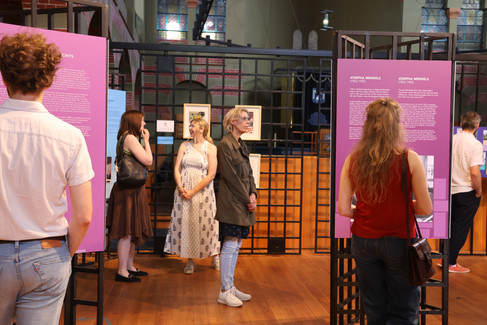Now on view: From Memory to Memorial
- Synagoge

- Jun 16
- 3 min read
Friday 13 June saw the opening of Synagogue Groningen's summer exhibition, 'From Memory to Memorial. Living with the war, after the war'. Writer Ron van Hasselt and singer-songwriter Jan Henk de Groot contributed to the opening event. Curator Lola van der Made provided an introduction to the exhibition's theme. In Groningen, we reflect on 80 years of liberation. A moment we often associate with joy and celebrations. But this exhibition arose from some difficult questions about the aftermath of the war.

How do you celebrate liberation when you have lost almost everything? When you don't know if your parents are still alive? Or your children? Or your friends? How do you process the trauma of persecution, exclusion and mass murder - as an individual, but also as a society? This exhibition is about those questions. About the Shoah. And about how we in Groningen - city and this province - have been searching for ways to remember and commemorate for 80 years. The title From Memory to Memorial already shows something: there is movement. The exhibition shows four layers of meaning.
1. From individual to collective
The title From Memory to Memorial describes a transition from the personal to the collective. Whereas remembering often starts with individual experiences, commemorating is something we do together. In public, visible to all. In this exhibition, we show how personal stories became intertwined with the larger story of Groningen. How private also became public history. From personal stories and silent mourning, to collective rituals, monuments and days of remembrance. Commemoration has thus become a way in which we as a society try to give meaning to the past.
2. From emotion to ritual
Memories are often raw, confrontational and complex. They can surface unexpectedly, and are often highly emotionally charged. Remembrance helps to give shape to them. For instance, through rituals, through silence, through togetherness. We look for language, for symbols, for moments when we can share grief, loss and also hope. That is what this exhibition makes visible.
3. From past to present
Remembering looks at the past: what happened, who we lost, what was damaged beyond repair. Remembering, on the other hand, is also about today. It is an active act: we choose to remember because we believe the past has meaning for today. We choose to stand still. To keep stories alive. And to bring new generations into it. In the exhibition, you will see how each time period reshapes commemoration. Nothing is fixed - it moves with the questions of today.
4. A warning and an appeal
We are losing the last eyewitnesses. Memories are fading. Without active remembrance, the past threatens to disappear. That is why From Remembering to Remembrance is also a call: Keep on remembering. Keep remembering. Not only out of respect for those who are no longer here, but also because it says something about who we want to be. As a city and as a community.
These four layers of meaning are reflected in the stories we show - of Jewish Groningers who survived the war, each with their own way of coping. But also in monuments, in celebrations, in silences. In what was spoken, and what remained unsaid for a long time. The exhibition is not all-encompassing, but tries to cover the gamut of how the culture of remembrance developed. How silences were slowly broken. How and for whom monuments have been erected. To ways of grieving together - and living on. And just today, 80 years later, commemoration is more important than ever. Because while we dwell here on a past of persecution and destruction, we also see today a world full of violence, war and polarisation. This demands something of us. That we continue to choose humanity - even when reality is complex. That we continue to oppose the dehumanisation of the other, anywhere.
Over the past 80 years, there has been much discussion about how, where and whom we commemorate. So the discussions going on today are not new. In this sense, commemoration is also a freedom: the fact that we may and can reflect, ask questions, make choices about what we want to remember. It is not a set ritual, but a living process. Remembering only means something because we choose to do it every time. You can see this exhibition at Synagoge Groningen until 12 October.

This exhibition has been made possible by a contribution from “80 years of freedom Groningen”. This is made possible by the Province of Groningen, all Groningen municipalities, vFonds, Stichting Beringer Hazewinkel, Cultuurfonds Groningen, Mondriaanfonds, Scholten Kammingafonds and VSB fonds. Helga de Graaf of Studio Eye-Candy took care of the exhibition design. Thanks to all loaners including the Groninger Archives, War and Resistance Centre Groningen, the Streekhistorisch Centrum in Stadskanaal and various private individuals who shared objects, photos and stories with us.










